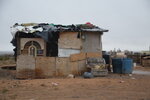



Driving south from Santa Fe to Juárez or Palomas, Mexico has become like descending into a cauldron. It was 81 degrees on July 26 when we left Santa Fe, 90 when we stopped in Placitas to pick up beans and rice from the Dignity Mission but 109 at the border at Santa Teresa. We’ve made four trips in the last month and the heat has become the dominant issue. If this heat continues, I predict another migrant surge, built on heat and climate change-related crop failures and increasingly unendurable living conditions. Cities like Phoenix may have consistently hotter temperatures, but we Americans have air conditioning, showers, swimming pools, shaded areas, crop insurance and all sorts of protections that simply don’t exist in the many Latin American countries from which migrants come.
Here are some examples from our recent trips that show the situation in Juárez and Palomas, Mexico.
On arriving at the barren courtyard of a mental asylum named Punto Zero on the west edge of Juárez, the first person to greet me was an older woman mental patient named Socorro. She was wearing a wool cap tied around her head and a thick fleece jacket. She stood motionless next to my car and seemed completely oblivious to the 109 degrees heat.
“She refuses to take that cap off,” Lupe, the director, said. Then Lupe tells me that their refrigeration is broken, and they are waiting for a repairman.
“And we’re almost out of food,” she adds. She had 38 mental patients to care for but luckily my trunk was full of the beans and rice from Dignity Mission.
Earlier when I came across the border, three women approached my car, Cecilia Vazquez, a Mixteca Indian from Oaxaca plus Graciela from Toluca, Mexico, and her daughter. For years, they have been coming up from Anapra where they now live to sell trinkets at this crossing, enduring the brutal heat in summer and the bone chilling winds in winter to try to eke out a living. I always pay them for photos and give them food and clothing. They had no shade to go to and seemed dazed by the heat but selling these trinkets meant survival.
The Recreativa Agua Park, the one public pool along the highway south of Santa Teresa was closed, the gate locked. However, the firemen in tiny Palomas, some 70 miles to the west had had a “sprinkle day” where kids could laugh, play and cool off under the water. There is no such thing in this area of Juárez; in fact, even the basic deliveries of water for cooking and household work have been delayed.
Some 600 houses in this area of Juárez are made of cinder block and were built by the non-profit, Siguiendo Los Pasos de Jesús. They have basic electricity but what about the hundreds of other houses made of patched together scraps of cardboard and plywood?
What about something as simple as shade? At Punto Zero there is a bench along the east side of a dormitory where there is shade. The patients sit there, slumped and silent, but there are no trees in this area on the west end of Juárez and none in Palomas. In fact, these areas are almost totally lacking in anything green. Due to the innovative work of the non-profit Border Partners, this may change in Palomas, at least in terms of vegetables and fruit, but that is a long-term project.
At Vision in Action, the other mental asylum I’ve been helping for a dozen years, there are roughly 120 patients, most of whom spend their days in a large open patio. Several years ago, we raised the money to close off about a third of the patio and create a space with air conditioning in the summer and warmth in the winter. I thought of it as an amenity but under today’s conditions of extreme heat, it is really about survival.
On Aug. 7, the alley behind the Sacred Heart church was full of young Venezuelans who were sleeping on the pavement. When we drove through there to deliver clothing, it was 109 degrees.
For many years these trips to take food and supplies to a variety of Mexican humanitarian programs were monthly. Now we go at least twice a month because the need is greater. Now the dominant theme on these trips is the weather. I have the air conditioned car but what about Cecilia Vazquez trying to sell trinkets at Santa Teresa or Socorro who doesn’t know she should take off her wool cap or the hundreds of migrants in crowded shelters. We Americans can escape – we have showers, air conditioning, refrigeration, irrigation for our crops and food supply – but in the countries from which so many migrants are coming, there are none of these protections.
Morgan Smith has been writing about conditions on the border for many years and can be reached at Morgan-smith@comcast.net.